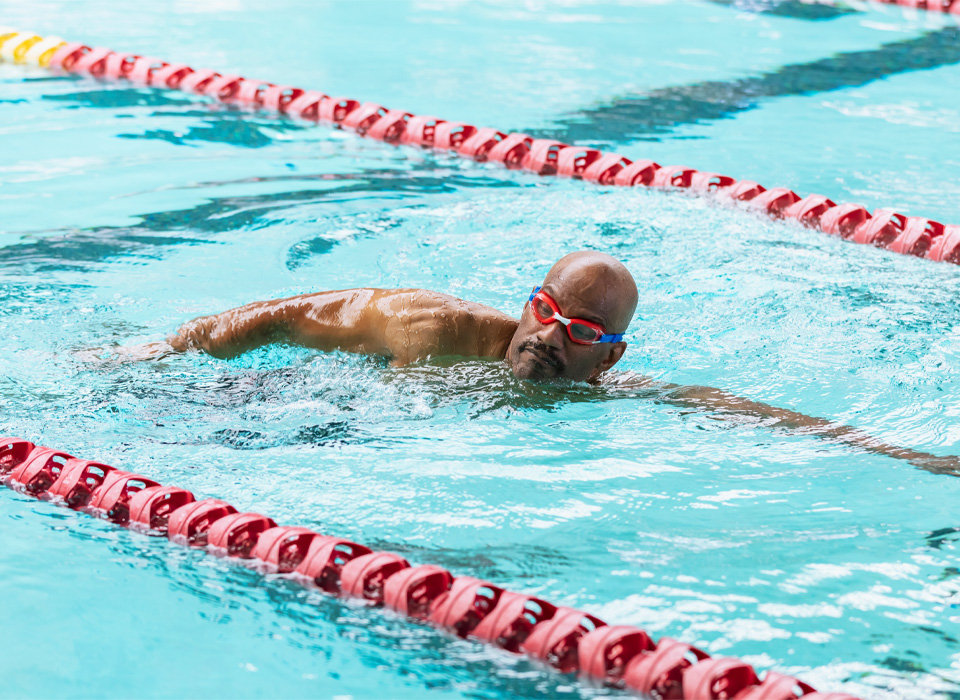What to Expect Following a shoulder labral repair surgery (SLAP, Bankart)
 in a lap pool" width="960" height="700" />
in a lap pool" width="960" height="700" />
Following a labral repair there is a typical protocol that is followed which guides the rehabilitation process. Proper healing takes months and you must be careful to not damage the repair.
Below are some general facts followed by a typical timeline. There can always be variations in the protocol depending on your particular surgery. The extent of the damage and complexity of the repair may affect your recovery.
- After your surgery, you will be sent home in a sling and given a prescription for pain medication. The doctor or nurse will advise you how to use these.
- You may have an ice machine to take home or just be instructed to use an ice pack. In either form, ice is highly encouraged to decrease pain and inflammation. You may ice as often as needed.
- Many people find it more comfortable to sleep in a recliner or propped up several pillows for a while after surgery. This is solely based on your preference.
0-4 weeks
- Expect to wear a sling for 4-6 weeks. This sling should be worn at all times including while you sleep unless otherwise directed by your doctor. The sling may be removed for bathing and to do prescribed exercises that your physical therapist will teach you. You may also take your sling off for brief periods throughout the day to let your arm hang at your side and relax.
- This phase of rehab is passive range of motion (PROM) only. This means you should not reach in any direction or use your arm to assist with lifting or daily activities.
- You will be able to do stretches and isometric exercises where you contract the muscles in your shoulder but your arm doesn’t move. You will be allowed to actively move your elbow, wrist, and hand.
- There will range of motion limitations in which your therapist will guide you. With labral repairs specific caution is taken with shoulder rotation away from your body, especially in combination with your arm out to your side.
4-6 weeks
- This is the active assisted range of motion (AAROM) phase. This is where your shoulder does some of the work to move with assistance from your other arm, either directly or utilizing some object like a cane or pole. Your physical therapist will teach you these exercises.
- You still should not lift your arm by itself or lift any object heavier than a coffee cup.
6 weeks
- This is when you begin performing active range of motion (AROM). Healing has progressed enough that you can safely reach away from your body with your arm. You should still not be lifting any heavy weight.
- Light resistance will be added as appropriate and should always be pain free.
12 + weeks
- At this point, strength and stability training progresses more aggressively.
- Sport specific exercises and training will begin if return to sport if one of your goals.
Considerations
- From the date of your surgery until full recovery will be 4+ months depending on your prior level of function and personal goals (i.e. sports). For optimal recovery, plan to be in therapy for 3-4 months. The frequency of your visits may vary throughout the duration of physical therapy depending on your rate of recovery and rehab phase. In the beginning, expect 2 times per week. If your progress is good and you have good compliance with your home program, frequency in the later stages often decreases to only 1 time per week.
- If you live alone, prepare your home before surgery such that you may function in it one handed. Remember, for the first 4 weeks, you will have minimal use of your involved arm.
Recovering from a shoulder operation such as this is a lengthy process that requires patience and consistency with the prescribed exercises. Your doctor and physical therapist will guide you through this process to return your shoulder to its pre-injury level.

 in a lap pool" width="960" height="700" />
in a lap pool" width="960" height="700" /> in a lap pool" width="960" height="700" />
in a lap pool" width="960" height="700" />